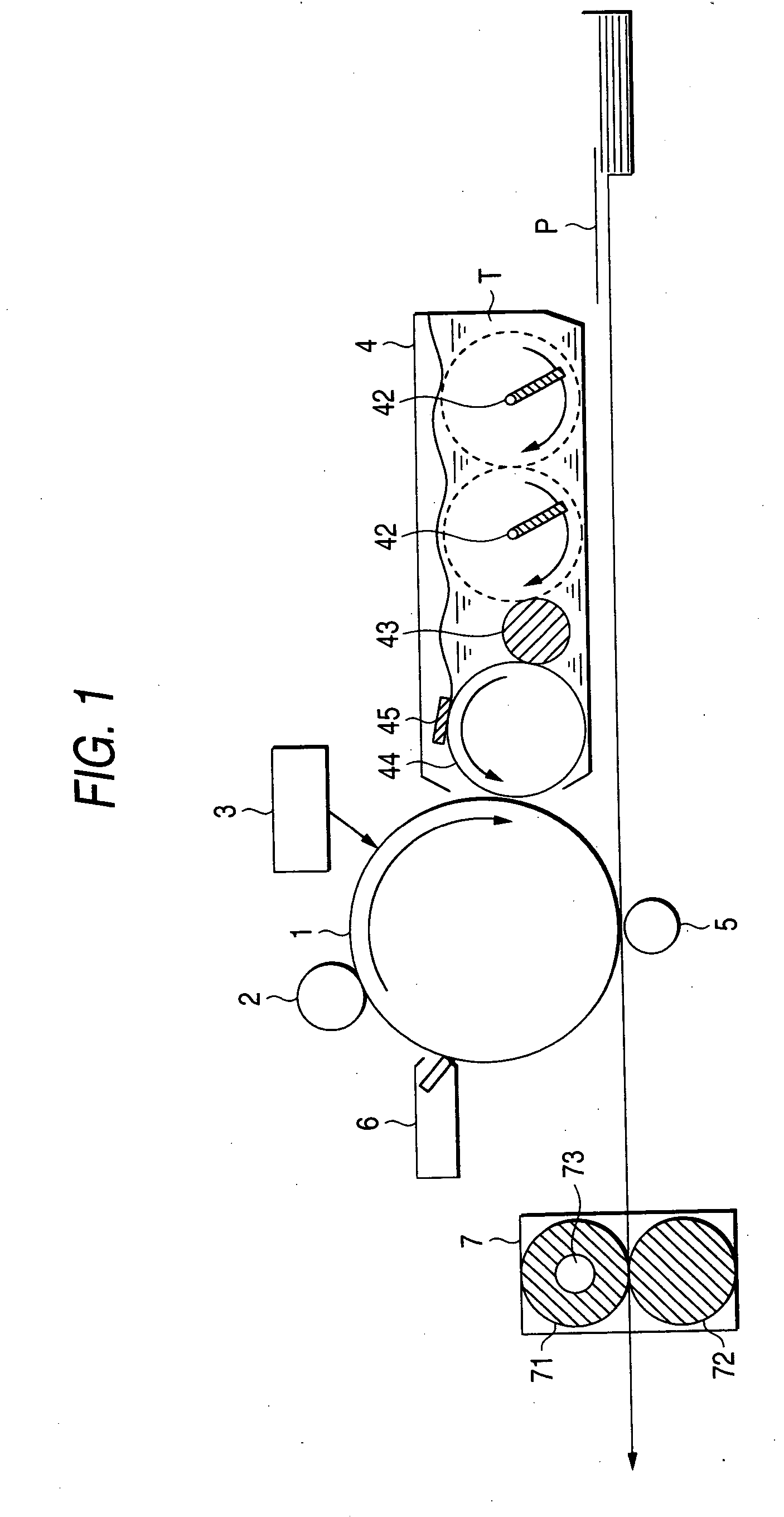Electrophotographic photoreceptor
a photoreceptor and electrochromic technology, applied in the field of electrochromic photoreceptors, can solve the problems of insufficient effect, achieve the effects of improving mechanical durability, poorer resistance to ozone, and high mechanical durability
- Summary
- Abstract
- Description
- Claims
- Application Information
AI Technical Summary
Benefits of technology
Problems solved by technology
Method used
Image
Examples
production example 1
Process for Producing Polyarylene Resin A
[0179] Measured amounts of sodium hydroxide (14.01 g) and H2O (1,120 mL) were introduced into a 1-L beaker. The contents were stirred with nitrogen bubbling thereinto to dissolve the sodium hydroxide. Thereto were added benzyltriethylammonium chloride (0.1744 g), bis (4-hydroxy-3,5-dimethylphenyl)methane [hereinafter often referred to as tetramethylbisphenol F or TmBPF] (23.79 g), and a mixture of bis (4-hydroxyphenyl)methane, (2-hydroxyphenyl)(4-hydroxyphenyl)methane, and bis(2-hydroxyphenyl)methane [BPF-D, manufactured by Honshu Chemical Industry Co., Ltd.; p,p′:o,p′:o,p′: o,o′=about 35:48:17] (7.96 g) . After the contents were stirred, the resultant aqueous alkali solution was transferred to a 2-L reactor. Thereafter, 2,6-dimethyl-4-tert-butylphenol (0.712 g) was added thereto.
[0180] Subsequently, terephthaloyl chloride (27.35 g) was dissolved in dichloromethane (560 mL), and this solution was transferred to a dropping funnel. The temper...
production example 2
Process for Producing Polyarylene Resin B
[0182] Measured amounts of sodium hydroxide (5.15 g) and H2O (426 mL) were introduced into a 1-L beaker. The- contents were stirred with nitrogen bubbling thereinto to dissolve the sodium hydroxide. Thereto were added p-tert-butylphenol (0.2155 g), benzyltriethylammonium chloride (0.0632 g), and bis(4-hydroxy-3,5-dimethylphenyl)methane [tetramethylbisphenol F] (12.68 g) in this order. After the contents were stirred, the resultant aqueous alkali solution was transferred to a 2-L reactor.
[0183] Subsequently, isophthaloyl chloride (3.12 g) and terephthaloyl chloride (7.14 g) were dissolved in dichloromethane (200 mL), and this solution was transferred to a 200-mL dropping funnel.
[0184] The temperature of the periphery of the polymerizer was kept at 20° C., and the dichloromethane solution was dropped thereinto from the dropping funnel over 1 hour while stirring the aqueous alkali solution in the reactor. After the reaction mixture was contin...
example 1
[0186] Ten parts by weight of D-form oxytitanium phthalocyanine which, when examined with CuKa characteristic X-ray, gave an X-ray diffraction spectrum having a main diffraction peak at a Bragg angle (2θ±0.2) of 27.3° was mixed with 150 parts by weight of 4-methoxy-4-methylpentanone-2. This mixture was treated with a sand grinding mill for pulverization and dispersion to produce a pigment dispersion.
[0187] On the other hand, 100 parts by weight of a 5% 1,2-dimethoxyethane solution of poly(vinyl butyral) (trade name, Denka Butyral #6000C; manufactured by Denki Kagaku Kogyo K. K.) was mixed with 100 parts by weight of a 5% 1,2-dimethoxyethane solution of a phenoxy resin (trade name, PKHH; manufactured by Union Carbide Corp.) to produce a binder solution.
[0188] To 160 parts by weight of the pigment dispersion produced above were added 100 parts by weight of the binder solution and an appropriate amount of 1,2-dimethoxyethane to finally obtain a coating fluid for charge-generating lay...
PUM
| Property | Measurement | Unit |
|---|---|---|
| boiling point | aaaaa | aaaaa |
| temperature | aaaaa | aaaaa |
| average primary-particle diameter | aaaaa | aaaaa |
Abstract
Description
Claims
Application Information
 Login to View More
Login to View More - R&D
- Intellectual Property
- Life Sciences
- Materials
- Tech Scout
- Unparalleled Data Quality
- Higher Quality Content
- 60% Fewer Hallucinations
Browse by: Latest US Patents, China's latest patents, Technical Efficacy Thesaurus, Application Domain, Technology Topic, Popular Technical Reports.
© 2025 PatSnap. All rights reserved.Legal|Privacy policy|Modern Slavery Act Transparency Statement|Sitemap|About US| Contact US: help@patsnap.com



